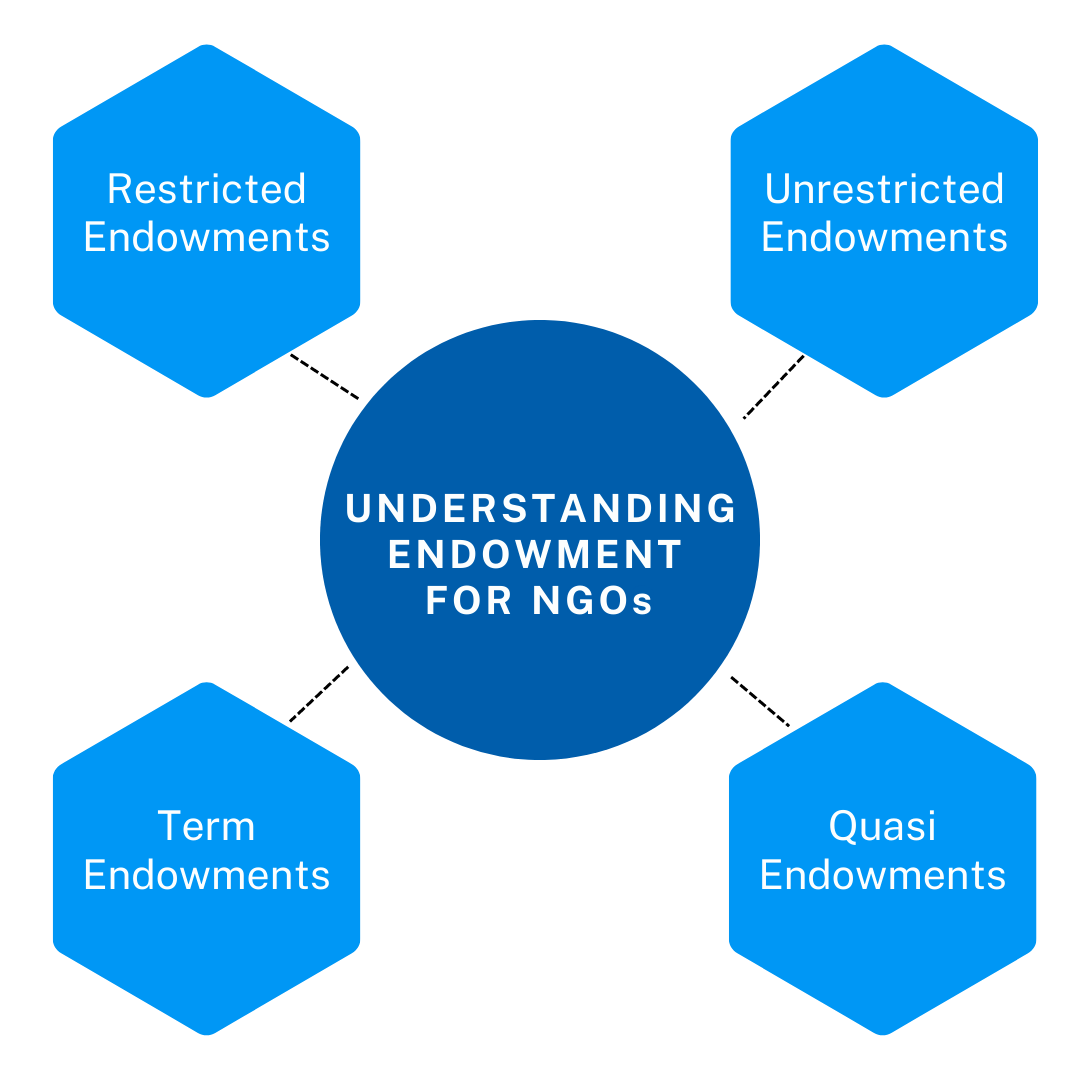What is an Endowment?
Endowments are funds put into long-term investments to grow the overall size of the endowment and generate annual income for the institution. In other terms, an endowment fund is also known as a “Principal”. Endowments are meant to last the lifetime of the institution, so there are usually limits on how much may be withdrawn from the endowment per year. Endowments are typically available to large institutions with many individual donors, such as universities, museums, hospitals, and religious institutions.
The endowment funds for the NGOs are sustainable financial resources that are invested to generate income in the future. An endowment for NGOs is a permanent fund that is set up to provide ongoing financial support for the organization’s mission and activities. This income can then be used to support the ongoing operations, programs, and projects of the NGO. Endowments are typically created by donors who contribute a substantial amount of money or other assets to the organization, with the stipulation that the principal amount is invested, and the income generated from the investments is used to support the organization’s work. However, it can be very difficult for NGOs to get funding for an endowment, especially from institutional donors.
Endowment funds play a vital role in the event of any emergencies or to maintain the consistency of the organization. Establishing an endowment fund can provide long-term stability and financial security, allowing the NGO to focus on its mission without being solely dependent on short-term donations or grants.
What are the types of endowment?

Restricted Endowments
The restricted endowments are the funds that are earmarked for limited use. These earnings are spent as per the donor’s specifications. In other words, these funds can be spent for the program or project of the organization but not for administration or organizational expenditures.
Unrestricted Endowments
Unrestricted funds are not earmarked or designated for a specific purpose or project within a nonprofit organization. Organizations may use these funds so long as they meet the aims and objectives of the group outlined in their governing document. In comparison to the restricted funds these funds are less challenging as nonprofits are not bound by limitations to spend the donation only on specific projects.
Term Endowments
Term endowments are allowed to be spent according to the donor’s specified time period. These funds are set for a certain period of time to support a specific purpose or cause over a defined period of time, usually for a set number of years or until certain conditions are met.
Quasi Endowments
Quasi-endowments are donations made by any organization or an individual, which are very typical. This fund is also known as the board-designated fund, which is a type of financial arrangement commonly used by NGOs and other nonprofit organizations. It’s not a traditional endowment in the sense of being permanently restricted, but it serves a similar purpose of providing financial stability and support for the organization’s mission.
How can your NGO create an Endowment Strategy?
Although NGOs with an endowment fund help to secure funding to run their program activities, it should be careful that creating and managing an endowment fund is not an easy task. It requires a lot of time, proper planning, a long-term perspective, and collaboration with financial experts. It’s an effective way to ensure the sustainability and growth of an NGO’s efforts to create positive change in the world. Of course, the size of the NGO does not matter when creating an endowment fund, but there should be a proper strategy when establishing one.
NGOs with an endowment fund help maintain their image among donors. It makes the donors believe the NGO is fulfilling its mission. This type of reputation among donors helps the NGOs attract other donors as well. But sometimes it can be tricky and lead the donors to believe the NGO no longer requires the fund, but the NGO should not stop seeking funds for fundraising activities. NGOs use the endowment funds depending on their program nature, restrictions, general operating budget, funding programs, and other organizational expenses.
Here are some points on how an NGO can create an endowment strategy:
Clear goals and visions
NGOs need to set a clear goal and path for their organization’s mission. The past organizational activities need to be transparent and clear so that donors do not hesitate to support you. Networking with donors is an important factor in receiving endowment funds for NGOs. The donors are keen to connect with an organization that has clear visions and goals.
Allocation of funding
If an NGO does not have a professional financial advisor, then hiring one is a must because a clear financial plan and strategy will support the mission of the organization. The clear allocation of funding needs to be recorded in the financial budget.
Develop investment policy
NGOs need to create an investment policy that outlines the guidelines for investing in the endowment fund’s assets. Consider factors such as risk tolerance, expected returns, asset allocation, and ethical considerations.
Risk management
Assess the potential risks associated with your investment strategy. Diversify your investment portfolio to mitigate risks and ensure stable long-term growth.
Fundraising strategy
Develop a proper fundraising plan to generate the initial funding for your endowment. This includes soliciting the major potential donors, networking with them, launching specific campaigns, and hosting events.
Transparency and Reporting
Implement a structured communication system that consistently updates donors on the endowment fund’s performance, investment strategy, and its direct influence on the organization’s operational activities. By transparently sharing information about financial growth, prudent investment decisions, and the tangible outcomes achieved through the fund’s support, donors will gain insights into the enduring impact of their contributions, fostering trust and reinforcing their engagement with the organization’s mission.
NGO endowment policy sample
An NGO endowment policy refers to a financial strategy where an NGO sets aside a specific sum of money or assets in a dedicated fund that generates interest or investment income. This income is used to support the organization’s mission and activities over the long term, ensuring its sustainability and minimizing dependence on external funding sources. Each NGO’s endowment policy varies from the others. It should be developed in consultation with legal and financial experts to ensure it complies with regulations and meets the organization’s specific needs and goals.
Here is an endowment fund policy of Chesapeake Bay Trust for reference:
[embeddoc url=”https://philantropia.org/wp-content/uploads/2023/08/Endowment-Policy-2.pdf” download=”all” viewer=”browser”]
Endowment funds are crucial for any NGO, as these funds help the organization generate income for future projects. It is basically not sufficient to cover all the program activities, but it definitely supports the NGO’s growth. These funds should not be spent for other organizational purposes; they should be invested so that they work as an income source for the organization. Charitable organizations that have endowment funds build an investment strategy and run their programs smoothly without any hindrances.

